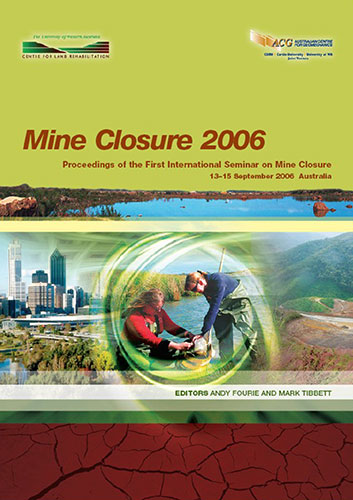Why Do Mines Close?

|
Authors: Laurence, DC |
DOI https://doi.org/10.36487/ACG_repo/605_1
Cite As:
Laurence, DC 2006, 'Why Do Mines Close?', in AB Fourie & M Tibbett (eds), Mine Closure 2006: Proceedings of the First International Seminar on Mine Closure, Australian Centre for Geomechanics, Perth, pp. 83-94, https://doi.org/10.36487/ACG_repo/605_1
Abstract:
This paper summarises the early results of a significant and on-going research project investigating the causes and impacts of mine closures over the past 25 years. The closure of the 800 mines provides a wealth of data, obtained from company and government records, interviews with key personnel and other sources. The data includes all Australian States and Territories and all commodities, including metalliferous, coal and industrial minerals. The majority of mine closures were in Western Australia (60%) followed by New South Wales (20%) and Queensland (10%). The most commonly closed mine was a gold mine followed by coal, nickel, base metals and minerals sands operations. Twenty five percent of the mines closed due to resource exhaustion or depletion; 24% due to high costs, price drops, or declining grades; 8% due to open pit resource depletion (but with underground reserves remaining) or underground reserves depleted (but plans to open cut remainder) and 7% due to receivership or voluntary administration. Other significant causes included closure of a downstream industry or loss of markets; adverse geological/geotechnical factors; flooding/inrush; government/political decisions; safety/health or environmental issues or other reasons. The environmental, social and economic impacts of these closures are also significant and include acid mine drainage and impact on mine employees. The outcomes of the research will equip operators and regulators to better manage future mine closures.
References:
Laurence, D.C. (2001) Classification of Risk Factors Associated with Mine Closure, Mineral Resources Engineering,
Vol.10, No. 3, pp. 315-331.
Laurence, D.C. (2002) Optimising Mine Closure Outcomes for the Community – Lessons Learnt Minerals and Energy,
Raw Materials Group, Vol. 17 No.1, pp. 27-34.
Laurence, D.C. (2006) Optimisation of the Mine Closure Process, Journal of Cleaner Production, Volume 14, Issues 3-
4, pp. 285-298 Elsevier Science Ltd.
Neil, C., Tykkylainen M. and Bradbury, J. (eds) (1992) Coping with Closure: An International Comparison of Mine
Town Experiences, Routledge, London, ISBN 0 415 06651 4.
Why Do Mines Close? D.C. Laurence
94 Mine Closure 2006, Perth, Australia
© Copyright 2025, Australian Centre for Geomechanics (ACG), The University of Western Australia. All rights reserved.
View copyright/legal information
Please direct any queries or error reports to repository-acg@uwa.edu.au
View copyright/legal information
Please direct any queries or error reports to repository-acg@uwa.edu.au